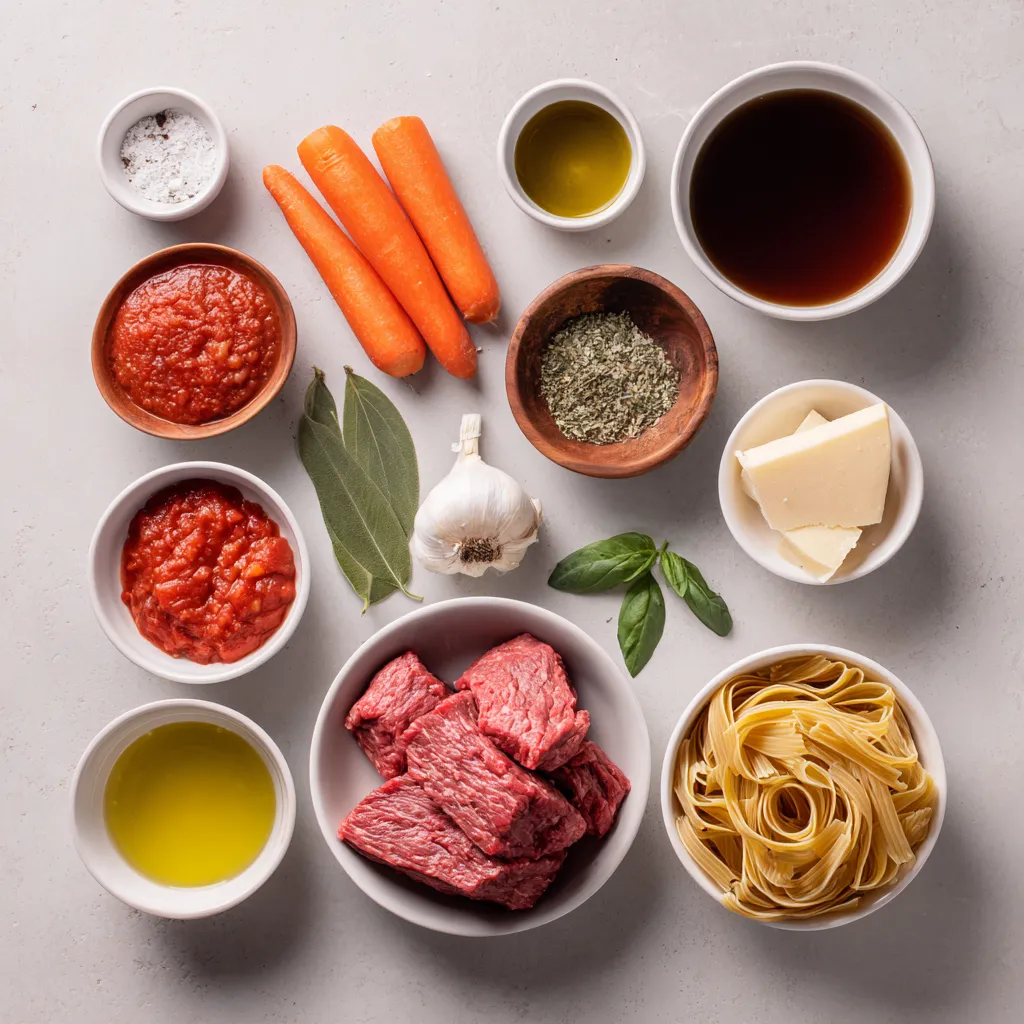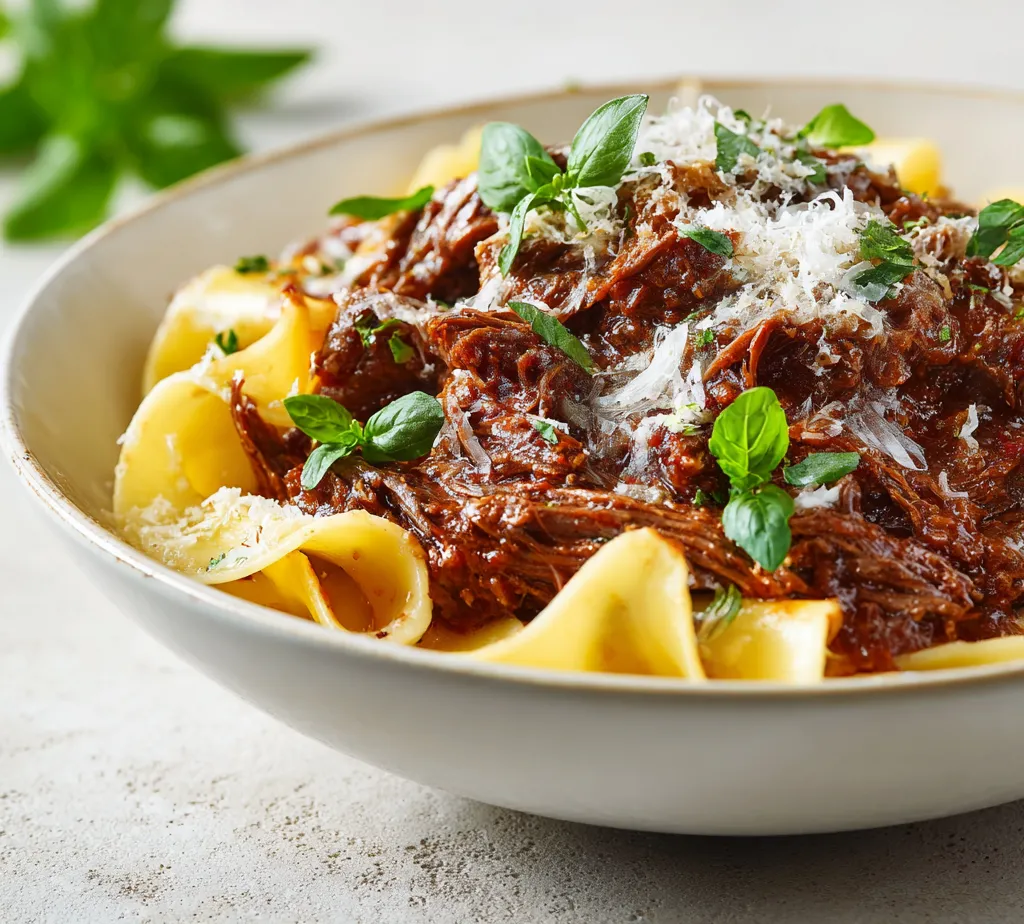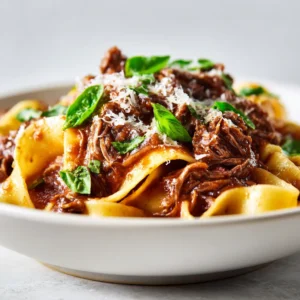Introduction
The chilly days call for warm, comforting meals that nourish both body and soul. One such dish that perfectly fits this description is Slow-Cooker Beef Ragu. This dish is not only packed with rich flavors but also embraces the convenience of slow cooking, making it an ideal option for busy weekdays or leisurely weekends. The beautiful melding of tender beef with a rich tomato sauce and a medley of vegetables creates a hearty meal that feels like a warm hug on a cold day.
Slow-Cooker Beef Ragu highlights the essence of home-cooked comfort food, delivering a satisfying dish that’s perfect for family gatherings or weeknight dinners. The slow cooking process not only tenderizes the beef but also allows each ingredient to infuse its flavors into the sauce, resulting in a delightful dish to serve over your choice of pasta.
As you prepare this savory beef ragu, you’ll be met with inviting aromas that will make your kitchen feel like a cozy Italian trattoria. Whether paired with pappardelle, tagliatelle, or any pasta of your choice, this dish will surely satisfy your cravings and warm you from the inside out.
Recipe Overview
– Total Time: 8 hours 20 minutes
– Prep Time: 20 minutes
– Cooking Time: 8 hours (low) or 4 hours (high)
– Yield/Servings: 6-8
– Difficulty: Not specified in the recipe
Ingredients
The ingredients used in this recipe are thoughtfully selected to build depth of flavor and create a satisfying meal. The essential ingredients include:
Beef
– 2 pounds beef chuck roast, diced into 2-inch cubes
– 1 tablespoon olive oil
– Salt and freshly ground black pepper, to taste
Vegetables
– 1 large onion, finely diced
– 2 cloves garlic, minced
– 2 medium carrots, peeled and chopped
– 2 celery stalks, chopped
Base and Flavor Additions
– 1 cup non-alcoholic red wine (such as grape juice or a red wine alternative)
– 1 can (28 oz) crushed tomatoes
– 2 tablespoons tomato paste
– 1 teaspoon dried oregano
– 1 teaspoon dried thyme
– 1 bay leaf
– 1 cup beef broth
Garnishes and Serving Suggestions
– Fresh basil leaves, for garnish
– Grated Parmesan cheese, for serving
– 1 pound pasta (ideal options: pappardelle or tagliatelle), for serving

Instructions
1. Brown the Beef: In a large skillet set over medium-high heat, warm the olive oil. Generously season the beef cubes with salt and pepper. Working in batches, add the beef to the skillet and sear each piece on all sides until beautifully browned. Once browned, transfer the beef to your slow cooker.
2. Sauté the Vegetables: In the same skillet, toss in the diced onion, chopped carrots, and celery. Sauté for approximately 5-7 minutes, or until the onions turn translucent. Stir in the minced garlic and continue to sauté for an additional 1-2 minutes until the garlic is fragrant.
3. Deglaze the Pan: Carefully pour the non-alcoholic red wine into the skillet, scraping the bottom with a wooden spoon to lift any flavorful browned bits left behind. Allow the mixture to simmer for about 2-3 minutes to reduce slightly and concentrate the flavors.
4. Combine Ingredients: Transfer the sautéed vegetable mixture to the slow cooker with the browned beef. Add in the crushed tomatoes, tomato paste, dried oregano, dried thyme, bay leaf, and beef broth. Mix everything together thoroughly.
5. Cook: Cover the slow cooker and cook on low for 8 hours, or on high for 4 hours, until the beef is exceptionally tender and pulls apart easily with a fork.
6. Cook the Pasta: About 15 minutes prior to serving, prepare the pasta according to the package instructions. Once cooked, drain and set aside.
7. Shred the Beef: After the cooking cycle is complete, take the beef out of the slow cooker. Using two forks, shred the beef into bite-sized pieces and return it to the rich sauce, stirring to incorporate well.
8. Serve: Ladle the hearty beef ragu generously over the pasta. Garnish with fresh basil leaves and a lavish sprinkling of grated Parmesan cheese for a delightful finish.
Preparing the Ingredients
Selecting the Beef
Choosing the right cut of meat is crucial for a successful beef ragu. Beef chuck roast is favored for its rich marbling and flavor, which breaks down beautifully during slow cooking. The marbled fat within the chuck roast ensures that the meat remains tender and juicy, providing that melt-in-your-mouth texture that is characteristic of a properly made ragu.
When selecting your beef chuck roast, look for vibrant red color and a good amount of visible fat. Avoid any meat that appears gray or overly lean, as it may not yield the best results in terms of flavor and tenderness.
Veggie Prep
Properly preparing vegetables enhances both the texture and flavor of the sauce. Dicing onions and mincing garlic are simple yet effective techniques to ensure the flavors infuse into the ragu. Start by peeling the onion and cutting it into small, uniform pieces; this will help it cook evenly. Similarly, mincing garlic releases its essential oils, imparting aromatic depth to the dish.
Carrots and celery add a mild sweetness and earthiness to the ragu, complementing the beef perfectly. Peeling and chopping these vegetables into even-sized pieces ensures they cook uniformly, contributing to the overall stability of the sauce.
Measuring Liquids
Using the right amount of liquid, particularly the non-alcoholic red wine and beef broth, is essential for achieving the desired sauce consistency. The non-alcoholic red wine not only adds complexity but also helps to deglaze the pan, lifting any flavorful bits stuck to the bottom. When measuring the beef broth, ensure you are using a high-quality product, as it will fundamentally affect the taste profile of the ragu. Adjusting these quantities slightly can help achieve a sauce that suits your preference for thickness and richness.
Cooking Technique: Browning the Beef
Importance of Searing
Browning the beef cubes creates a flavorful crust that enhances the overall taste of the dish. It’s important to work in batches to avoid overcrowding the pan. Overcrowding can lead to steaming rather than searing, which won’t provide that delicious depth of flavor. Target a golden-brown color to indicate a good sear, ensuring that the natural sugars in the beef are caramelized to elevate the dish’s richness.
This step is crucial because it not only develops flavor but also creates a beautiful contrast in texture with the tender beef that will become infused in the sauce during the slow cooking process.

Sautéing the Vegetables
Choosing the Right Skillet
For the sautéing stage of the recipe, it is beneficial to use a skillet with a heavy bottom. A heavy skillet retains heat well and helps to achieve an even sauté, preventing the vegetables from burning. Make sure the skillet is adequately heated before adding the olive oil; this ensures the oil does not smoke excessively and creates the perfect environment for the vegetables to soften. Keeping the sautéing temperature at medium-high allows for a quick caramelization without losing the moisture in the vegetables.
Timing for Sautéing
Proper timing is crucial in this step to develop flavors without overcooking the ingredients. The onions should take about 5-7 minutes to become translucent. This indicates they are softening without browning too much, which can alter the flavor profile. Once the onions are translucent, the minced garlic can be added and sautéed for an additional 1-2 minutes until fragrant. Be sure to watch the garlic closely, as it can turn bitter if allowed to brown excessively.
Deglazing the Pan
Techniques for Deglazing
Deglazing the pan is the process of adding liquid to a hot skillet to lift flavorful browned bits stuck to the bottom, known as fond. In this recipe, the non-alcoholic red wine plays a pivotal role. When you pour the wine into the hot skillet, it instantly sizzles and helps to loosen these bits, which, once incorporated into your sauce, add depth and richness. Use a wooden spoon to gently scrape the fond while the wine is simmering.
Reducing the Wine
Allow the wine to simmer for about 2-3 minutes. This step is essential as it reduces the wine slightly, concentrating its flavors and ensuring that the alcohol evaporates. A well-reduced wine not only enhances the sauce’s flavor but also contributes to a balanced acidity that rounds out the dish nicely.
Combining All Ingredients
Layering Flavors
Layering ingredients into the slow cooker helps develop the overall flavor profile of the ragu. The crushed tomatoes provide a base, while the various spices including oregano, thyme, and bay leaf add complexity. Make sure to add the beef and sautéed vegetables first, followed by the liquids, to ensure that everything cooks evenly and flavors meld together effectively.
Mixing Thoroughly
Once all ingredients are in the slow cooker, take the time to mix them thoroughly. This ensures each piece of beef and vegetable is evenly coated with sauce and that the spices are distributed uniformly. An even distribution leads to consistent flavors throughout the dish, enhancing the overall eating experience.
Slow Cooking Process
Temperature Settings
Choosing the correct setting on your slow cooker can make all the difference in achieving tender beef ragu. The low setting (ideal for the 8-hour cooking duration) allows flavors to meld gradually while breaking down the meat fibers, leading to a meltingly tender texture. Alternatively, if you’re short on time, the high setting (4 hours) can also yield great results but may result in slightly less tender meat.
Timing for Optimal Tenderness
To achieve the fork-tender consistency that is the hallmark of a good beef ragu, it’s essential to respect the cooking times for proper tenderness. Whether you choose low or high heat, monitor the dish towards the end of the cooking time. The ragu should be ready when the beef easily shreds with a fork, ensuring it absorbs the sauce’s flavor thoroughly.
Cooking the Pasta
Pasta Selection
For the best pairing with beef ragu, pasta selection is key. Pappardelle, with its wide ribbons, or tagliatelle, known for its thick strands, are ideal choices. These types of pasta have the surface area needed to capture the hearty sauce, resulting in a satisfying bite.
Timing for Cooking
Cooking the pasta just before serving is crucial. This timing ensures that the pasta remains al dente and hot, complementing the ragu’s richness. Follow package instructions for timing carefully, as overcooked pasta can become mushy and unappealing.
Shredding the Beef
Techniques for Shredding
Once the cooking time is complete, remove the beef from the slow cooker using a slotted spoon to prevent excess sauce from clinging. Use two forks to shred the beef into bite-sized pieces or, for easier shredding, you can also use a meat claw if you have one on hand. Aim for a shred size that will blend well with the sauce and pasta, achieving balanced bites.
Reintegrating the Beef
After shredding, return the beef to the slow cooker and stir well to ensure every piece is coated with the ragu sauce. This step enhances the flavors of the dish, allowing the meat to soak in the hearty, rich sauce before serving.
Serving Suggestions
Presentation Tips
When it comes to serving the beef ragu, presentation can elevate the dining experience. Serve it in warm, shallow bowls to foster a cozy and inviting atmosphere. A scattering of fresh basil leaves not only adds visual appeal but also contributes a fresh herbal note. A light sprinkle of freshly cracked black pepper and a drizzle of olive oil on top can further enhance the flavors.
Accompaniments
Consider pairing the dish with a side of rustic bread. A thick slice of crusty bread is perfect for soaking up the remaining sauce and adds a delightful textural contrast to the tender meat and pasta. This combination transforms the meal into a comforting feast, perfect for chilly days.
Conclusion
The Comforting Slow-Cooker Beef Ragu offers a rich and hearty flavor experience, with tender beef simmered to perfection in a robust tomato sauce. The combination of textures from the ragu, pasta, and garnishes creates a fulfilling meal that is both satisfying and warming, ideal for cold weather. With an approximate total time of 8 hours and 20 minutes, this ragu recipe allows the ingredients to meld beautifully, ensuring every bite is packed with flavor.


